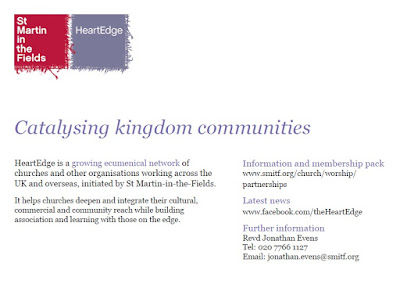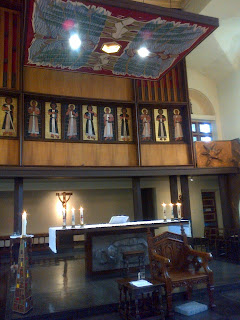Last night we enjoyed a wonderful Bread for the World Service at
St Martin-in-the-Fields with a temporary installation of the
'Light the Well' community art project led by artist
Anna Sikorska, plus songs and music including: Like a candle flame - Kendrick, Longing for light - Ferrell, This little light of mine - arr. Raney, Kindle a flame - Bell, Lord Jesus Christ your light shines within us - Taize, Anthem - Cohen, In a world where people walk in darkness - Shephard, and The Lord bless you and keep you - Rutter. The service was followed by lantern-making and discussion groups, after refreshments.
Here is the reflection that I gave as part of the service:
In 2014 the artist
Grayson Perry made a
vase as a portrait of
Chris Huhne, the Liberal Democrat politician who fell from grace when his wife, Vicky Pryce, revealed that he had asked her to take the blame for his speeding offence and the speeding points incurred. He resigned from the cabinet and was subsequently jailed for perverting the course of justice. Perry thought that Huhne was unchanged by his prison experience and, therefore, represented powerful white males with a kind of bullet-proof, Teflon, confidence and chutzpah that was unaffected by wrongdoing and failure. As a result, Perry purposefully smashed the finished vase and then had it repaired using an ancient Chinese technique which involves lacquer resin dusted or mixed with gold, saying, “I have smashed the pot and had it repaired with gold to symbolise that vulnerability might be an asset in relationships to such a person.”
St Paul told the Christians in Corinth that they had the light of the knowledge of the glory of God in the face of Jesus Christ in their hearts, but that this treasure was in clay jars, so that it might be made clear that this extraordinary power belongs to God and did not come from them (
2 Corinthians 4. 6 - 12). If the clay jar, the container of the light, were to be perfectly formed, then the light inside would not be seen from the outside. The light of Christ would effectively be hidden. Like people looking at the confidence and chutzpah of the Teflon-coated Chris Huhne, people would look at our perfect life and not Christ, because they would only see us. Instead, St Paul says, because we are not perfect and have difficulties and flaws we are like cracked clay jars, meaning that it is then clear that where we act or speak with love and compassion, this is because of Christ in us, rather than being something which is innate to us or simply our decision alone. He used this image of light in containers seen through cracks, or thin translucent clay, to assure the Corinthian Christians that they had the light of God in their lives, despite the fallibility and frailty of those lives. Similarly,
Leonard Cohen sings in 'Anthem': ‘Ring the bells that still can ring / Forget your perfect offering / There is a crack, a crack / In everything / That's how the light gets in, / That's how the light gets in’.
The artist Anna Sikorska is helping us reflect on these themes through ‘Light the Well’, the community art project which she is undertaking together with the
artists and craftspeoples group. The project involves making porcelain lanterns (glazed ceramic globes) like those in front of the altar. The size, surface decoration and character of each lantern will differ, although the base material - and overall look - is consistent white ceramic, roughly made. The lanterns are made by laying strips of porcelain onto a round support. Porcelain clay glows with a transparency individual to itself but those of you that make lanterns later after this service will realise that in order to be as translucent as possible the strips of porcelain need to be as thin as possible. Once made, they are fired and the lanterns are then suitable for being outside. They develop cracks in the firing, through which the light inside will also be seen. In the Light Well these lanterns will be joined together with cord covering the stone floor in a random constellation. The cord also connects a light bulb within each lantern, so each one will shine from within.
These cracked translucent lanterns lit from within are a visible realisation of St Paul’s image of light in clay jars. By linking the lanterns together, this installation will also highlight another aspect of this passage. Paul writes that ‘We are afflicted in every way, but not crushed; perplexed, but not driven to despair; persecuted, but not forsaken; struck down, but not destroyed; always carrying in the body the death of Jesus, so that the life of Jesus may also be made visible in our bodies.’ Paul writes of us in the plural. We are afflicted, but not crushed. We are perplexed, but not driven to despair. It is as we come together to engage with affliction, perplexity, forsakenness, and being struck down that we carry in our body the death of Jesus and show the life of Jesus. It is as we come together, linked, like the lanterns, by the light of Christ that we become the Body of Christ.
I don’t know how the image of a crack letting in light came into the mind of Leonard Cohen but it fits really well with St Paul suggesting that there are fractures and flaws running through each of our lives and that these imperfections actually enable the light within to be seen more clearly. I don’t suppose that Grayson Perry had this passage in mind when he smashed the Chris Huhne vase and had the resulting cracks gilded with gold, but, like St Paul, he suggests that our vulnerabilities are the most precious aspect of our lives; of more significance than a confident pride in ourselves that will not acknowledge weakness.
Dietrich Bonhoeffer wrote that to ‘be a Christian does not mean to be religious in a particular way, to make something of oneself ... on the basis of some method or other, but to be ... the [person] that Christ creates in us. It is not the religious act that makes the Christian, but participation in the sufferings of God in the secular life …
following Christ results in the liberation of the self to exist for and with others .. "The Christian ... must drink the earthly cup to the dregs, and only in his doing so is the crucified and risen Lord with him, and he crucified and risen with Christ." Bonhoeffer could thus say that Christ takes hold of Christians at the centre of their lives, while at the same time recognizing that it also Christ who launches Christians into a world of suffering and difference. Hurled into the midst of this world, Christians are not to assume a sense of privilege but are to relinquish privilege for the sake of others …
To be claimed by others is … to participate in the vulnerable God's existence for us. In contrast to a "religion" that can only offer smug reassurance, bourgeois comfort, and pious quietism, the "new life" to which Jesus calls his followers is fraught with risk.
Bonhoeffer … claimed that God is revealed in the world precisely in those places that the world is most prone to ignore: in suffering, rejection, and scorn. The God of Jesus Christ takes these anathemas, makes them God's own, and invites all disciples to participate in them.’
(
https://www.thefreelibrary.com/Religionless+Christianity+and+vulnerable+discipleship%3A+The+interfaith...-a098313403)
Each of us are like cracked or translucent clay jars because of our flaws and vulnerabilities. It is through these lines of stress – the suffering, rejection and scorn with which we engage - that the light of Christ is seen. It is as we join together in living for the sake of others – linked together as the lanterns will be linked in the Light the Well installation – that we become the Body of Christ and reveal him most fully in the world. In this way, the Light the Well community art project and installation will show us what it means to be the Body of Christ – the Church – in the world today.
---------------------------------------------------------------------------------------
Joe Raney (arr) -
This Little Light Of Mine.


































